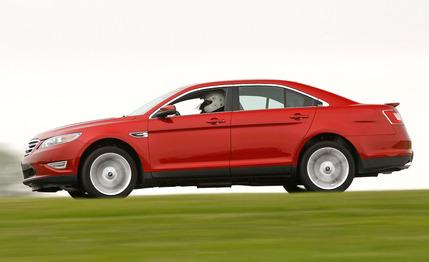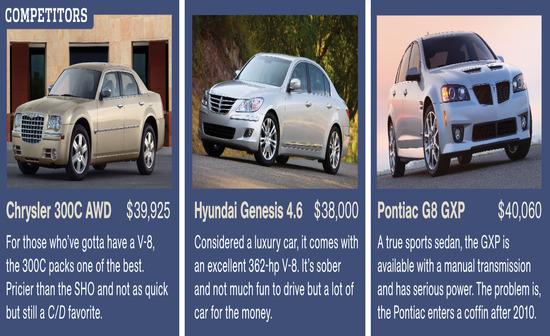 Road Test
Road Test
Owners of the original Ford Taurus SHO, gathered at a Taurus Car Club of America track day at GingerMan Raceway in South Haven, Michigan, are slightly startled as they approached the massively high greenhouse and roofline of the latest 2010 Taurus SHO. “It’s big, seems bigger than the last,” one of them says while closely examining the VIN of our early-build test car.
The reaction seems about right to us as the new Taurus is a massive, 8/7ths-scale car that’s more than half a foot taller than Ford’s first super-high-output version of its Taurus family sedan. This latest SHO, which returns after a 10-year hiatus, has the same awkward proportions of the weird Outback sport-utility/sedan model that Subaru used to make, except that Ford’s tasteful design tries to hide the SUV-like size and succeeds.
It’s a new world out there, SHO faithful, but we imagine you already know that. Twenty years ago, your 220-hp SHO was the third-quickest sedan in the country, outrun only by the BMW M5 and 750iL. But today, most family sedans equipped with V-6 engines make more than 250 horsepower and are quicker than that first SHO. We almost feel bad for first-gen SHO owners because watching a V-6 Camry—with an Elmo sun blocker and a baby seat—pull away from what was once the American sports sedan must play hell on memories of what used to pass for speed.
What happened to the SHO? Arguably, the disarmament campaign began in ’92, just four years after its debut. That second SHO suspiciously offered, for the first time, an automatic transmission. The 1996 Taurus SHO that followed was yet another attempt to capture more sales in the calmer waters of the mainstream. Speaking of water, that SHO was the one that looked like an automotive tribute to the noble lungfish. Weak, heavy, bulge-eyed, and—in that iteration—sold only with an automatic transmission, that last SHO before the hiatus seemed like little more than a cynical attempt to mine the scrap of credibility the letters S-H-O had acquired.
Even true believers have to admit the third generation didn’t quite live up: “I bought one of the last ’99 SHO models, thinking it might be a collector’s item one day,” a Taurus clubber recalls. “I kept it until I was beaten by a Pontiac Grand Am GT in a drag race.”
Now, more than a decade later, a new Taurus SHO has arrived, and it’s large, but is it in charge? And why is this new SHO so big? Possible explanation: After the Fusion came along to compete with the Taurus’s previous rivals, the Camry and the Accord, the pressure was off the Taurus to compete for mainstream family-sedan sales, and as a result, it bloated into obesity. And racked by the news that its big brother, the Crown Victoria, had become fleet-sales only, the Taurus continued to expand, to its current length of 202.9 inches. What we now have is a Taurus SHO that weighs 4346 pounds—998 pounds more than the original.
Fortunately, Ford has added some super-high output to mitigate the super-high mass. For the first time, a Yamaha-built engine is not under the hood of a SHO. Not to worry: Ford’s 3.5-liter “EcoBoost” V-6 makes 365 horsepower at 5500 rpm and 350 pound-feet of torque at 3500 rpm. The engine features direct fuel injection, variable intake-valve timing, and two small turbochargers that put out a maximum of 12 psi of boost. Power delivery is impressively immediate and like a small-block V-8’s; a high static compression ratio of 10.0:1 helps eliminate any feeling of turbo lag. The engine gives no hints that it’s turbocharged—there’s no whistling, no waiting, no signs that intake-air molecules are being forced together like veal calves except perhaps our as-tested fuel economy of 16 mpg. Even at a steady 80 mph, our Taurus had trouble topping 20 mpg.
Throughout the day at GingerMan, we repeatedly hear “Do a burnout!” and “Light ’em up!” yelled at us. But the standard all-wheel-drive system of the SHO allows only a brief shriek of the front wheels before the power is sent rearward. The Performance package on our test car includes a shorter final-drive ratio, which helps the SHO surge forward with more authority from a stop. Launching it is easy: Hold your foot on the brake, raise the revs, and release the brake. It rips to 60 mph in 5.2 seconds, 0.2 second quicker than the V-10–powered Audi S6. From U.S. highway speeds, the SHO accelerates into triple digits as if it were raised in Germany. But the 133-mph governed top speed—that’s 10 mph lower than the 1989 original’s—is a major clue that this car wasn’t designed with the autobahn in mind.
While the engine’s ability to move the SHO through space is hard to fault, the intake and exhaust tracts seem to have taken the credo, “silence is golden,” too seriously. Even when revved toward the 6200-rpm redline, the intake and exhaust systems emit only the briefest of snarls, indistinguishable from the naturally aspirated V-6 in the base Taurus. Few noises of any kind permeate the SHO’s double-pane front glass and acoustically treated windshield glass. If it weren’t for the constantly changing scenery, you’d almost never know the SHO was in motion. Suspension noise is almost nonexistent, and the sturdy structure is imperturbable. The measured 70 decibels at 70 mph was a surprise, as the SHO seems dead silent. Trust us, there isn’t enough ambient noise to hide even the daintiest flatulence.
